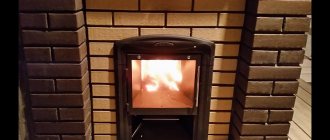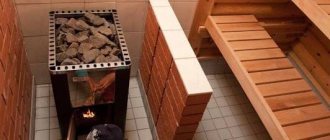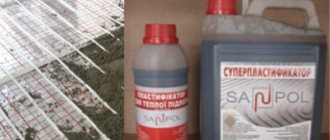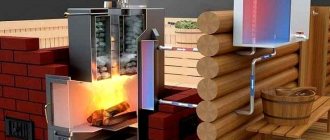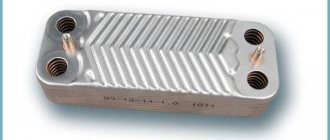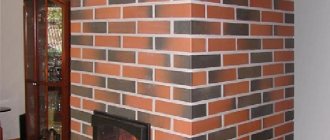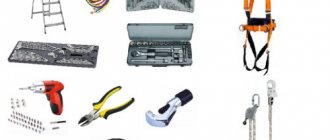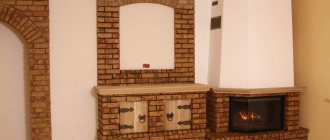Metal stoves have gained great popularity among home bath owners in recent years. The reason for this was the ease and speed of installation and affordable pricing. However, they have a number of disadvantages, ranging from unpresentable appearance to the likelihood of a fire. The finishing of the stove in the bathhouse is carried out to reduce negative factors.
Decorative finishing of the stove
Distance from wooden wall to stove
During operation, the temperature of the metal stove in the bathhouse reaches about 4000. Metal heated to such a temperature can cause a fire in nearby wooden structures. For fire safety purposes, there are permissible distances from a metal heating source to the wall established by SNiP. In the absence of protective screens, the distance should be at least 1 meter.
In large rooms, maintaining such a distance is not difficult. But if the question concerns a small home bath, every centimeter of space is important. To reduce the permissible distance, a number of measures are taken:
- install protective screens around the stove itself;
- sheathe sections of walls located in close proximity to the source of ignition.
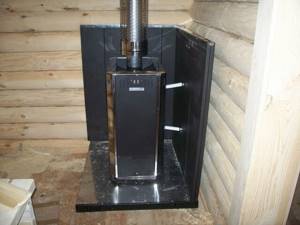
Installing protective screens around the stove
Metal screens
Installation of steel sheets allows you to reduce the fire hazard distance. It is enough to maintain a distance of 50 cm from a wooden surface to a steel screen. Metal protective screens can be either factory-made or welded independently. During installation, it is necessary to create a ventilation gap between the heating part of the stove and the metal screen. The presence of a ventilation duct helps heat the casing up to 1000. Factory screens are equipped with legs and fasteners; using them, installing the sheets will not be difficult.
Tiles
Tiles are a classic solution for finishing stoves. They have cheap production technology and very reliable installation. The external surface, finished with tiles, looks like high-quality, thick tiles.
This appearance will be achieved only if you use tiles without a pattern on the front surface. They do not produce a special decorative effect, since they do not differ much from the usual tiles. The only benefit is in the strength of the fastening, which is why other tiles with a three-dimensional pattern on the front side are more popular.
Tiles are laid in the same way as tiles, but require a significant thickness of the finishing layer. If a portal for a sauna stove is made from them, then part of the wall and floor is covered with tiles. They don’t have to be used on the floor if the stove foundation is raised above the floor by one or two brick rows.

If the tiles have holes for wire, then it must be used.
The diameter of the rods is selected according to the instructions. Larger diameter means higher strength, but the complexity of installation increases.
On average, tiles are the same thickness as one brick.
They can just as well be used to create the same protective layer.
Brick screens
There are two options for installing a brick screen:
- a brick partition is erected only between the wooden wall of the bathhouse and the metal stove;
- The oven is covered with brick walls on all sides.
It is enough to leave a distance of 10-15 cm between the wooden wall and the brick screen.
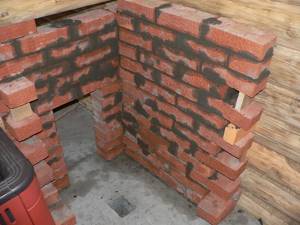
A brick partition is erected only between the wooden wall of the bathhouse and the metal stove
Covering walls with heat-reflecting screens
Reflective cladding is a heat-insulating material covered with a stainless steel sheet on top. This option allows you to reduce the distance from the protective coating to the working surface of the stove to 38 cm. Non-flammable, durable materials with low thermal conductivity are used as a protective layer that prevents the wooden surface from catching fire:
- basalt wool (basalt canvas, basalt slabs, basalt cardboard), sometimes called stone wool. Made from rock (basalt), it is an environmentally friendly material. It does not emit harmful compounds when heated, and can withstand temperatures up to 6000 without breaking down or losing its properties. It has good water-repellent ability, does not absorb moisture at all and does not cause corrosion of adjacent materials;
- mineralite slabs - the main component in them is cement. They can withstand temperatures of 6000, but the operating temperature at which the properties do not change is 1500. Absorbs and releases moisture well. Minerite is harmless to the respiratory tract when heated;
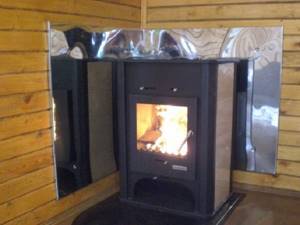
Covering the walls of the bathhouse around the stove with heat-reflecting screens
- asbestos boards or asbestos cardboard. Some consider it a carcinogenic material that is harmful to health, but this has not been scientifically proven. Asbestos dust can cause harm to the body if inhaled. Covered with a metal sheet on top, asbestos has proven itself to be a good thermal insulation material;
- slabs made of expanded vermeculite do not contain asbestos and are made of mountain mica. They have low specific gravity and high mechanical strength. Such slabs can be coated with a layer of plaster and covered with ceramic tiles.
The heat-insulating layer is covered with a stainless steel sheet on top. In some cases, galvanized iron is used, but it is “transparent” to IR rays. The polished surface of the steel is able to reflect heat rays, directing them back into the bathhouse.
Metal sheets are mounted on ceramic mounts that are not subject to strong heat. For free circulation of air flows, preventing heating of the wooden wall, it is necessary to provide a ventilation gap. To do this, a ventilation gap is provided between the heat-insulating layer and the wall. The screen is mounted, leaving a distance above the floor and above the ceiling.
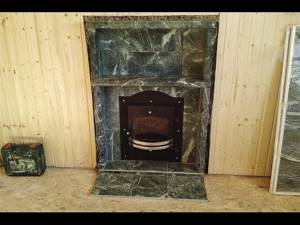
Asbestos has proven itself to be a good thermal insulation material
Preparing the furnace for work
Before finishing, preparatory work cannot be avoided. They are needed for smooth application of plaster and high-quality wall cladding. The first step is to remove the old plaster if the stove has been used before.
This process is carried out with a spatula and water. If the old plaster contains cement, then you will have to use a chisel or hammer. If the old material is successfully removed, the wall should be cleaned down to the brickwork.
The next step is to run a wire brush or sander over the surface of the oven.
Important! To properly attach the plaster, you will need to spray the walls with water and clean the seams between the bricks. New masonry must be dried and cleaned of dust and other defects.
New masonry must be dried and cleaned of dust and other defects.
After cleaning, the walls need measurements. Using a building level, the correctness of the corners is assessed and, if necessary, they need to be plastered to level them.
Sheathing followed by cladding
You can ensure an aesthetically presentable appearance of the bathhouse by decorating the heat-insulating layer with fire-resistant tiles, the installation of which must be done with heat-resistant glue. To ensure high thermal insulation protection of the wooden surface from the heat of the stove, fire-resistant materials are mounted on it, which can be used as:
- glass magnetic sheets, resistant to high temperatures and high humidity. They are characterized by high elasticity and mechanical strength. When heated, they do not emit toxic substances;
- expanded vermiculite sheets;
- mineralite slabs.
Finishing the stove in the bathhouse - choosing cladding and tips
For tiling with ceramic tiles the following are mainly used:
- porcelain stoneware;
- tiled tiles;
- clinker;
- terracotta.
Tile is not entirely suitable for decorating stoves. It is commonly believed that this is just the name of a ceramic slab, but this is not so. Its ability to withstand overheating is much lower than other options.
We can say that such material is a relic of the past, but if the choice still falls on it, additional protection will be required in the form of heat-resistant adhesive for lining stoves. In addition, it will not be possible to use glazed tiles.
Each tile manufacturer has a certificate of conformity, which details the characteristics of the material.
Of the listed options, porcelain stoneware most meets the requirements for finishing tiles; the material itself is extremely durable; many manufacturers use mass dyeing followed by firing, that is, even if chipping occurs, the color inside the slab is exactly the same as on the decorative surface.
Facing types: tiles
The following types of tiles have proven themselves well for cladding thermal insulation areas:
- Terracotta tiles. Eco-friendly unglazed tiles made from colored clay without mechanical impurities through long-term firing in ovens. It has increased heat resistance and does not emit harmful substances or specific odors when heated. During operation it does not lose its original color. It has a color palette from gray to beige. It has textured options for wood and stone. Able to retain heat for a long time.
- Clinker tiles are made from slate clay. It is fired at a temperature of about 12000 in one cycle. Does not cause harm to health during the heating process. Such tiles are durable, have increased resistance to abrasion and color loss. The palette of produced colors ranges from black to white.

Facing tiles around the stove in the bathhouse
- Porcelain tiles. Artificial finishing material consisting of clay, quartz sand and kaolin. It withstands humid environments and high temperatures well and is not destroyed by thermal shock. Has a long service life. Manufacturers produce glazed, matte, polished porcelain tiles, structured to resemble leather, wood, and stone.
- Soapstone tiles. A natural material of mountain origin, often gray in color, but interspersed with brown, cherry, yellow and green shades. Withstands repeated heating and high humidity, accumulates and releases heat well.
Installation of a brick casing around a metal plate
The brick casing for shielding the furnace has significant weight, and a prerequisite for its installation is the presence of a foundation.
Foundation structure
If the brickwork around a metal stove is made in a bathhouse that has already been built, the floor covering will have to be dismantled. The size of the concrete base is calculated by adding the size of the brickwork 20 cm + ventilation gap 10 cm + horizontal dimensions of the metal furnace. Installation begins by selecting a layer of soil. The depth depends on the degree of soil freezing and is about 60 cm.
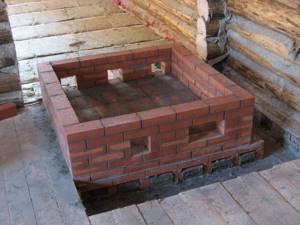
Reinforcing grid under the stove in the bathhouse
In the case of close groundwater, geotextiles or roofing felt, well coated with bitumen mastic, are laid on the bottom and sides of the pit. A sand cushion is installed on the base of the resulting pit. The sand is laid wet and compacted thoroughly. A layer of gravel or crushed stone is poured on top and compacted. Add another layer of sand 15 cm thick.
- assemble a reinforcing grid from reinforcement or metal rods, with a cell size of 10*10;
- pour concrete mortar, not reaching the edges of the pit by 10 cm;
- after this, the concrete needs time to “mature” for three weeks;
- several layers of roofing material are laid on top of the concrete base and a heat-resistant slab is installed;
- lay a continuous row of bricks, which should not protrude beyond the boundaries of the refractory sheet; voids in the masonry are also unacceptable. Excess solution is immediately removed;
- the second row is laid similarly to the first, but with offset seams;
- observance of the horizontal plane is considered a mandatory condition.
What else to consider when filling the heater
To get the maximum benefit and pleasure from bath procedures, just knowing the rules for laying stones is not enough. It is also advisable to understand their impact on health, be able to determine the required loading volume, and clean and replace them in a timely manner.
How much stone do you need?
When buying a ready-made factory furnace, they focus on the characteristics declared by the manufacturer and select equipment of the required power. As a rule, the volume of the heater in such stoves is sufficient to warm up and maintain the temperature in the steam room, the size of which the stove is selected for.
When installing a homemade brick or metal heater, the required number of stones is calculated based on the volume of the room. It is believed that for every cubic meter there should be about 40-50 kg.
Preparation of mortar for masonry
You can purchase a ready-made solution in a store or use a sand-clay mixture. To determine the best ratio of sand and clay, make a small batch from which a cylinder or bar is formed. Pay attention to the possible appearance of cracks, the absence of which is an indicator of quality.
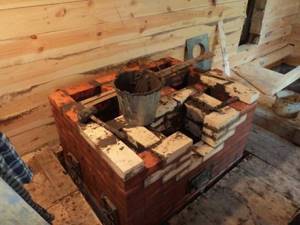
Preparing masonry mortar for a stove in a bathhouse
It is preferable to use clay used for masonry from deep layers, without earthen and mechanical impurities.
To give the clay the required consistency and plasticity, it is kept in water for several days, after which it is ground through a sieve to remove debris. A 1:1 proportion of clay and sand is considered good; liquid is added to it in small portions. A high-quality mixture does not stick to the trowel and does not drip from it. When running a trowel over the solution, the mark left behind should not blur or have a torn structure. To improve the quality of the masonry, add rock salt at the rate of 0.1 kg per bucket of finished mortar. It is also good to add cement and fireclay powder.


